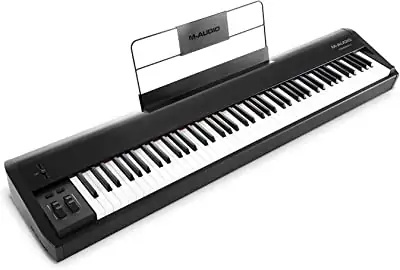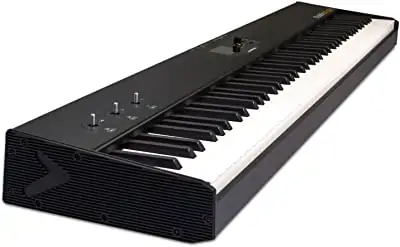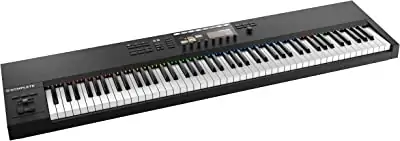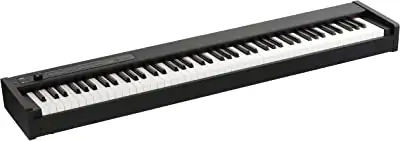MIDI keyboards are a great piece of equipment. They are excellent for any performing artist, and are a fundamental part of any studio.
The options available are seemingly endless, however. This can make choosing the right MIDI keyboard a nearly impossible task.
Top 3 - Weighted MIDI Keyboards
Preview | Product | Price |
|---|---|---|
That is why I have scoured the market and picked a handful of the best MIDI keyboards that also have weighted keys. Here are my top 7 picks.
Best MIDI Keyboards with Weighted Keys
1. Native Instruments Komplete Kontrol S88
Native Instruments is well known in the synth and MIDI space. Their instrument software is highly regarded for its high-quality, accurate instrument recreations.
This high-quality has been carried over to their hardware as well. The latest version of the Komplete Kontrol keyboard is one of their best MIDI controllers yet.
Native Instruments’ aim with the Komplete Kontrol was to keep you focused on the keyboard itself. They wanted you to spend less time looking up at your screen and using a mouse.
This keyboard is especially useful for composers and arrangers, as it finally provides access to the vast world of Native Instrument’s Kontakt libraries. These libraries are a crucial part of film composers' and music producers' workflow.
I've been using Kontakt for my film scoring work and recordings for over 12 years now, and one thing I always found frustrating was trying to quickly load and find new sounds.
The Komplete Kontrol keyboard solves that beautifully, as I can browse and see only the necessary information to choose from my extensive library.
The game-changing feature is the LED backlight keys. These lights are not just for showing which keys you're pressing, like in a beginner’s keyboard, but they are actually customizable lights.
This is significant for arrangers and producers because you can assign different lights to different instrument sections.
For example while working with strings, your purple lights can represent cellos and basses, green lights for violas, and yellow lights for violins. Instantly, you can see the organized layout of the orchestra on the keyboard. It's brilliant.
To top it all off, this keyboard is a great substitute for a grand piano, as it features a Fatar keyboard with real hammer-weight action. As a pianist myself, I can attest that the action of this keyboard feels very realistic.

My only complaint is that, in a way, the interface of this keyboard is a bit too simple. I wish they had added a few other controllers, such as CC sliders and maybe even a few drum pads.
This is the 88-key version, and there is a lot of space on the top side of the keyboard. It feels like a missed opportunity to me.
2. M-Audio Hammer 88
The M-Audio Hammer 88 is a perfect blend of simplicity and functionality. It offers a great playing experience without being bogged down by unnecessary gimmicks.
The first thing I noticed was the excellent build quality. Where other M-Audio controllers can feel a bit cheap and plastic, the Hammer 88 is solid.
That is definitely thanks to the entire top panel being metal. This keyboard isn’t going to break any time soon, or easily.
It also has a very sleek, unassuming look. But what it lacks in appearance, it more than makes up for it with its usability and playability.
The best part of this keyboard, in my opinion, has to be the keys. These are some of the best feeling weighted keys I have played in a while. It even beats keyboards twice its price.
In terms of controls, the Hammer 88 is rather barebones. You are only getting a pitchbend, a mod wheel, and a volume slider.
I prefer having at least some controls to be able to switch through sounds and do some basic tweaking easily. But with the Hammer 88, you have to do everything through the software editor.
Thankfully, the included software will have you making music in minutes. The Hammer 88 comes bundled with Ableton Live Lite and the Hammer 88 Preset Editor.
The Hammer 88 is also very heavy. This is a keyboard that is going to live on your desk and not be moved around much. Its limited controls also make it more suited to a studio environment, rather than playing live.
But these are just minor issues compared to just how great the Hammer 88 is. If you are looking to start a home studio, or just looking to expand your current setup, this is a definite winner.
3. Studiologic SL88
Studiologic’s SL88 Studio is a fairly straightforward MIDI keyboard, with some unique tricks up its sleeve. It is a well-built, fully-weighted 88 key keyboard, great for both studio work and live performances.
The keybed is a bit heavier than you will find on an acoustic piano. But I still found it to be a very enjoyable and comfortable experience while playing. The keyboard also has aftertouch, allowing for greater control while playing.
The coolest part of the SL88 are the three joysticks. Where other keyboards will use wheels for pitch and modulation, the SL88 uses three joysticks.
This means that you have control in two dimensions, not just one. Each joystick is also configured slightly differently.
The first will jump back to the center when released, the second only partially, and the third won’t jump back at all. Each can also be assigned to a specific function.
This lets you determine how you want your pitch, mod, or filter cutoff to function. Do you want the filter cutoff to stay when you release the joystick? Or the modulation to reset?
I also like the small screen at the top of the keyboard. Since you can split the SL88 into four zones, the screen gives you a quick overview of the sound or patch assigned to each zone.
You can also select each zone by clicking the encoder knob. This gives you access to the volume and other settings of that zone.
Each zone can be adjusted independently, with settings for the joysticks, pedal settings, key responsiveness, etc., making each zone unique and the SL88 highly versatile.
These are basically the extent of the controls on the SL88. But I think there is more than enough here for effective and easy use of the keyboard.
4. Korg D1
Korg is one of the most well-known names in the keyboard space. Some of the most renowned high-end keyboards are made by them.
Their D1 keyboard takes that high quality, and makes it far more affordable for the average person - all without compromising the experience of playing a Korg.
The biggest selling point of the D1, in my opinion, is the RH3 keybed. This is Korg’s ‘real hammer’ keybed design, which is featured on their high-end Kronos and SV-1 keyboards.
This means you are getting the same excellent weighted feel of their much more expensive keyboards, giving you a similar playing experience to what you would have on one of their flagship keyboards.
On the control side of things, the D1 is much simpler than some of Korg’s other offerings. I think they have done an excellent job with keeping the controls as simple and straightforward as possible, while still giving you plenty of options.
The controls are split into two. The left side has controls for touch sensitivity, EQ, reverb, chorus, and brilliance.
On the right, you have access to the 30 onboard sounds. These are organized into 10 categories, which makes finding a specific sound quick and easy.
One design feature I love about this keyboard is that the designers at Korg placed the controls all the way to the left instead of the center. While some may see this as a problem, thinking that controls in the center are easier to tweak, here's why I think it's a great feature.
I use this keyboard live, and I love placing effects, pedals, and an iPad controller on top of it. It can be problematic when the LED display and buttons are in the center because then I have to place some pedals on the left and some on the right, or vice versa.
However, with this keyboard, I find it perfect for controlling effects and editors on my iPad during performances.
Additionally, in the studio, I sometimes place a trackpad and a USB micro key keyboard on top of whatever controller I'm using. I find the surface layout of the D1 keyboard to be the best designed yet.
While all of the onboard sounds are great, I do feel that some are a bit lacking. The piano and Wurlitzer in particular aren’t quite as good as on some other high-end keyboards.
This isn’t a deal breaker, though. The quality is still high enough that you will be more than happy with them on stage and in the studio.
The D1 also doesn’t have a USB connection which I find a bit strange. That means no connecting to a PC or Mac, and no editing or swapping out sounds.
5. Roland A-88 MKII
The Roland A-88 has been a popular keyboard for quite a while. But after 10 years in the business, it was certainly time for an update.
The A-88 MKII is just that, an update that refreshes a tried and tested design. It brings some much welcome improvements, without sacrificing what made the original so great.
My favorite part of the A-88 is definitely the controls. All of the controls are on the left side of the keyboard.
This means that you don’t have to zig zag across the keyboard to change settings and effects. Everything is grouped very nicely and within reach of each other. Once you get the hang of it, you will easily be able to control most of the keyboard’s functions with just your left hand.
The controls are also highly customizable. The A-88 has 8 pots and 8 touch-sensitive pads.
Each pot and pad can be assigned to control a different effect or setting, or each pad can be assigned an entire patch. The pots and pads are also backlit, meaning you can color code them or even group them together.
There is also a total of 16 banks, meaning you can have up to 16 sounds, effects, settings, etc. assigned at once, and then simply switch between banks 1-8 and 9-16 with the press of a button.
Having the controls on the left side of the keyboard does make it slightly wider than others. But that also reduces its depth quite a bit. Along with its lower height, the A-88 is quite compact, and I found that it doesn’t take up too much space, provided you have a long enough desk. It can also slide underneath a desk quite comfortably.
Another major advantage of the A-88 is the incredible feel of its PHA-4 keyboard. I had the Roland XV-88 controller for a while, but I switched to this Mark II because of its amazing responsiveness and sensitivity.
Roland is well-known for their incredibly smooth MIDI response for key velocity. This has always been one of my gripes with many weighted keyboards.
As a pianist who has a Steinway in his studio, I have always felt that velocity translation in weighted keyboards was a little lacking. However, the Roland curve is as close to perfect as possible.
Moreover, many piano libraries, like Synthogy’s Ivory 2, have an option to designate the A-88 as your input controller, matching the velocity curve perfectly.
For all you pianists out there, this one might be the one to get.
The A-88 is expensive, though. This high price may make it unaffordable for most people, but it is definitely a worthwhile investment if you can afford it. Considering its ability to serve as a digital or real piano replacement, I believe it is reasonably priced.
6. Nektar Impact GXP88
The Nektar Impact GXP88 has a lot going for it. This is a truly impressive piece of gear that left me very pleasantly surprised.
Right off the bat, the weight, or rather lack of weight, caught me by surprise. This keyboard is extremely light, coming in at just 18lbs.
This is a keyboard that isn’t just going to sit in your studio, this is a keyboard that you will be taking with you to gigs. You are going to want to take it to gigs as well. The GXP88 was definitely made with players in mind. With its 88, full sized keys, it is gig ready right out of the box.
The keys are semi-weighted, though, and not fully weighted. You can, however, select between five velocity curves. Which means that you should be able to set the GXP88 to be just right for you.
The GXP88 also scores big with its controls. All of the controls are on the left side and top left of the keyboard, making all the controls easy to reach and use.
Where the GXP88 especially wins me over, is with its inclusion of transport controls. This lets you control the record, play, stop, etc. functions of your DAW.
You can also select tracks and patches. This helps to streamline your work flow so much. You can control almost your entire recording session straight from the keyboard.
On the top, you have controls for tempo, time signature, preset sounds, etc. But the GXP88 also has a unique feature called Repeat.
If you hold a key down, it will be repeated until you release it. You can then adjust the rhythm, rate, velocity, musical style, etc.
Considering the price of the GXP88, you are getting a lot more bang for your buck. This is an incredible pick for anyone wanting to get started with music production.
7. Novation 61SL MKIII
Novation’s new SL MKIII range of MIDI controllers brings some great new features, but does cut back on others. The SL comes in both a 61 key and 49 key variant, giving you a choice depending on your needs.
Because this is just a 61 key controller, its range is limited compared to an 88 key controller. If you don’t need 88 keys, then you can certainly use the SL on stage.
The keys are full-sized, semi-weighted, and equipped with aftertouch. So, even though your range is more limited, you aren’t losing out on the actual feel of playing.
But with the limited number of keys, the SL is a better suited as a studio controller. The controls are also designed in a way that gives the SL more of a studio feel.
There are a lot of buttons, pads, pots, and even faders on the SL. This gives it a level of versatility and control that many other similarly priced controllers don’t.
The MKIII has half the faders and pots as the MKII, however. This is going to be a downgrade for many, but I think it makes the MKIII a bit more focused. More importantly, it makes the MKIII a bit more approachable for newcomers.
With the number of buttons and lights on the SL, it is going to be intimidating to use for anyone not as familiar with MIDI controllers. But if you are willing to put in the time to learn how to use this keyboard, you will be rewarded with a versatile, highly usable and customizable keyboard.
While you can certainly use the SL for live performances, I think it is a much better fit for the studio. This keyboard is just much easier to use in a studio where you aren’t rushed to perform a certain action as fast and as accurately as possible.
Choosing the Right Weighted MIDI Keyboard

As with any other instrument, the MIDI controller you choose is going to depend on a number of different factors. It is important to know what you are looking for in a MIDI controller and what you think you will need before making a purchase.
Number of Keys
The first choice you will have to make is the number of keys you need. Keyboards come in a number of different key configurations.
While MIDI controllers can come with as little as 16 or even 8 keys, they usually have 25, 49, 61, or 88 keys. The number of keys is going to determine what you can do on the controller.
Controllers with less keys are often limited to being used for sequencing or triggering specific sounds. These can be used for live performances, but you won’t be playing them like a traditional keyboard.
Controllers with 49 and 61 keys are great for playing live, but are also excellent for production. Not only are they much more compact and easier to use, they usually also have an extended array of controls that help with production.
If you are planning on using your controller as a more traditional keyboard, playing more piano music, an 88 key controller would be much better. These keyboards give you the full range of a piano, and also play much more like pianos.
Key Weight
This is going to be a bit more subjective, but you should also consider the weight of the keys. Keys are usually labeled as fully weighted, semi-weighted, or synth.
The weight of the keys refers to the resistance of the keys, or how hard you need to press them to produce sound.
Fully weighted keys are going to be closer to what it feels like to play a piano. This is perfect if you already play piano, and they give much better tactile feedback. This allows for much more expressive playing, especially if the keyboard comes with aftertouch.
The big downside of keyboards with fully weighted keys is that they are more expensive. This is due to fully weighted keys being harder to design and produce.
Semi-weighted are less resistant than fully weighted. If you don’t need your keys to feel like a real piano, or just find fully weighted keys a bit difficult to play, semi-weighted keys are a nice middle ground.
Synth keys are the lightest of the three. They offer very little resistance, making them ideal for faster playing. If you aren’t a pianist, then synth keys will likely be the best option for you. Controllers with synth keys also tend to be more compact and lighter.
Velocity Response
I briefly mentioned this subject when describing my love for the Roland A-88, but I want to clarify that there is a misconception that keyboards with a realistic piano feel and nice weighted action will also control piano libraries in VST form in the same way.
I have found this not to be the case.
I have used expensive keyboard workstations that feel great, but when trying to trigger sounds from Spitfire Audio and Ivory, I have been disappointed by the limitations of their MIDI velocity transfer.
You would think that using USB and high transfer rates would solve this problem, but it is actually not a glitch. It is a built-in limitation of the key sensors on many of these keyboards.
My advice would be to try these keyboards in your own studio and return them if you don't feel they are versatile enough to also play VST libraries. I believe that sample libraries generally offer higher quality than most built-in sounds.
Additionally, if you plan on using drum libraries like BFD or advanced string libraries, realistic execution of MIDI velocity is crucial to get the most out of those samples. Therefore, it is a major factor to consider and test for yourself.
Aftertouch
You will often see a keyboard has something called aftertouch. What this basically means is that the keys have two levels of pressure that can be applied.
When you press down harder on a key, you activate the aftertouch. This sends a second MIDI signal that then alters certain values of the note being played.
Aftertouch is basically an easy way to add some extra expressiveness to your playing. It simulates the way you control the intensity of a note on a piano, depending on how hard you hit the key.
Controls
While many keyboards are fairly straightforward, having just some basic pitch and mod controls, others can have a ton of different controls.
This is another area where the number of controls you want will depend on your needs. If you are just going to use the keyboard for live performances, you likely won’t need a lot of extra controls.
At most, you will probably just need some basic controls that allow you to quickly cycle through the different sounds of the keyboard. But additional controls are definitely going to open up the possibilities with your controller.
Pads, pots, faders, buttons, these are all going to give you more options. They will allow you to control different aspects of your sound like the EQ, add effects, and even create custom sounds.
If you are planning on using your controller for production work, I would recommend getting one with some sequencer pads, programmable buttons, and even some transport controls for your DAW.
Especially, if you're a producer or artist using clip-based DAWs like Ableton Live or FL Studio, having trigger pads to launch clips might be really important for you. It also saves you from having to buy an external controller if you want to do this live.
In this case, the Novation keyboard is a great option. Since Novation also makes controllers specifically for some of these DAW companies, they're experts in clip performance and comprehensive control of these complex DAWs.
Another control that I can't stress enough is how important CC sliders have been for me as a composer and arranger. I don't know if any of you are planning to create orchestral mock-ups and demos for film scoring, but getting realistic sounds out of in-the-box orchestras is all about getting CC controllers perfectly dialed in during automation.
I've always found using a physical fader or knob much better than using a trackpad and mouse.
The more things you can control directly through your controller, the better. This is going to streamline your workflow, making sessions much more productive.
Included Software and Compatibility
Most MIDI controllers come bundled with trial versions of other software like sound editors and DAWs like Ableton Live. This is great if you want to learn how to use audio software, or want to try out a new DAW.
While the included software should be compatible with other software, and most software will be compatible with any MIDI controllers, there are exceptions.
The Native Instruments Komplete Kontrol, for example, can only be used with the Komplete Kontrol software, or third-party software that supports the NKS plugin format. So, just make sure that you have software that is compatible with the MIDI controller you are looking to purchase.
Closing Thoughts
Whether you are looking for an affordable alternative to a big, expensive piano, or something to take your music production to the next level, MIDI keyboards are the perfect piece of gear.
And with some many options out there, even if the right one for you wasn’t on this list, I know you will be able to find it with the tips I provided.
As always, here's my top tip: if you've got the patience, make sure to test out your preferred keyboard in your own studio before committing to it.
We all have our own preferences, and when it comes to making music, it's important to feel like the tool is tailor-made for you, the artist.









Great review… For the SL88 one important feature that deserves a mention (normally found in higher tier priced midi controllers) is that you can set the sensitivity of each key on a note by note basis. This is called key balance.
Great summary,,thanks